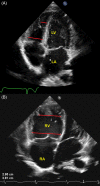Right ventricular base/apex ratio in the assessment of pediatric pulmonary arterial hypertension: Results from the European Pediatric Pulmonary Vascular Disease Network
- PMID: 29896859
- PMCID: PMC6489923
- DOI: 10.1002/clc.22994
Right ventricular base/apex ratio in the assessment of pediatric pulmonary arterial hypertension: Results from the European Pediatric Pulmonary Vascular Disease Network
Abstract
Background: Echocardiographic determination of RV end-systolic base/apex (RVES b/a) ratio was proposed to be of clinical value for assessment of pulmonary arterial hypertension (PAH) in adults.
Hypothesis: We hypothesized that the RVES b/a ratio will be affected in children with PAH and aimed to correlate RVES b/a ratio with conventionally used echocardiographic and hemodynamic variables, and with New York Heart Association (NYHA) functional class.
Methods: First we determined normal pediatric values for RVES b/a ratio in 157 healthy children (68 males; age range, 0.5-17.7 years). We then conducted an echocardiographic study in 51 children with PAH (29 males; age range, 0.3-17.8 years).
Results: RVES b/a ratio was lower compared with age- and sex-matched healthy controls (P < 0.001). In children with PAH, RVES b/a ratio decreased with worsening NYHA class. RVES b/a ratio inversely correlated with RV/LV end-systolic diameter ratio (ρ = -0.450, P = 0.001) but did not correlate with RV systolic function parameters (eg, tricuspid annular plane systolic excursion) and correlated with cardiac catheterization-determined pulmonary vascular resistance index (ρ = -0.571, P < 0.001). ROC analysis unraveled excellent performance of RVES b/a ratio to detect PAH in children (AUC: 0.95, 95% CI: 0.89-1.00, P < 0.001).
Conclusions: The RVES b/a ratio decreased in children with PAH compared with age- and sex-matched healthy subjects. The RVES b/a ratio inversely correlated with both echocardiographic and hemodynamic indicators of increased RV pressure afterload and with NYHA class, suggesting that RVES b/a ratio reflects disease severity in PAH children.
Keywords: Echocardiography; End-Systolic Base/Apex Ratio; Pediatric; Pulmonary Arterial Hypertension; Right Ventricle.
© 2018 Wiley Periodicals, Inc.
Conflict of interest statement
GH currently receives grant support from the German Research Foundation (DFG; HA 4348/6–1, KFO311). The authors declare no other potential conflicts of interest.
Figures



Comment in
-
Diagnostic and prognostic value of echocardiography in pulmonary arterial hypertension.Clin Cardiol. 2018 Sep;41(9):1150-1151. doi: 10.1002/clc.23036. Epub 2018 Aug 20. Clin Cardiol. 2018. PMID: 30069895 Free PMC article. No abstract available.
-
Reply to "Diagnostic and prognostic value of echocardiography in pulmonary arterial hypertension".Clin Cardiol. 2018 Sep;41(9):1152-1153. doi: 10.1002/clc.23038. Epub 2018 Aug 21. Clin Cardiol. 2018. PMID: 30069929 Free PMC article. No abstract available.
Similar articles
-
Right ventricular end-systolic remodeling index in the assessment of pediatric pulmonary arterial hypertension. The European Pediatric Pulmonary Vascular Disease Network (EPPVDN).Pediatr Res. 2020 Aug;88(2):285-292. doi: 10.1038/s41390-020-0748-2. Epub 2020 Jan 10. Pediatr Res. 2020. PMID: 31923914
-
The right ventricular outflow tract in pediatric pulmonary hypertension-Data from the European Pediatric Pulmonary Vascular Disease Network.Echocardiography. 2018 Jun;35(6):841-848. doi: 10.1111/echo.13852. Epub 2018 Mar 5. Echocardiography. 2018. PMID: 29505663
-
Parameters of Right Ventricular Function Reveal Ventricular-Vascular Mismatch as Determined by Right Ventricular Stroke Work versus Pulmonary Vascular Resistance in Children with Pulmonary Hypertension.J Am Soc Echocardiogr. 2020 Feb;33(2):218-225. doi: 10.1016/j.echo.2019.09.013. Epub 2019 Dec 10. J Am Soc Echocardiogr. 2020. PMID: 31836268
-
Prognostic Value of Right Ventricular Strain Using Speckle-Tracking Echocardiography in Pulmonary Hypertension: A Systematic Review and Meta-analysis.Can J Cardiol. 2018 Aug;34(8):1069-1078. doi: 10.1016/j.cjca.2018.04.016. Epub 2018 Apr 25. Can J Cardiol. 2018. PMID: 30056845
-
Right heart and pulmonary vessels structure and function.Echocardiography. 2015 Jan;32 Suppl 1:S3-10. doi: 10.1111/echo.12227. Epub 2014 Sep 19. Echocardiography. 2015. PMID: 25244348 Review.
Cited by
-
Diagnostic and prognostic value of echocardiography in pulmonary arterial hypertension.Clin Cardiol. 2018 Sep;41(9):1150-1151. doi: 10.1002/clc.23036. Epub 2018 Aug 20. Clin Cardiol. 2018. PMID: 30069895 Free PMC article. No abstract available.
-
Update on noninvasive imaging of right ventricle dysfunction in pulmonary hypertension.Cardiovasc Diagn Ther. 2020 Oct;10(5):1604-1624. doi: 10.21037/cdt-20-272. Cardiovasc Diagn Ther. 2020. PMID: 33224776 Free PMC article. Review.
-
Reply to "Diagnostic and prognostic value of echocardiography in pulmonary arterial hypertension".Clin Cardiol. 2018 Sep;41(9):1152-1153. doi: 10.1002/clc.23038. Epub 2018 Aug 21. Clin Cardiol. 2018. PMID: 30069929 Free PMC article. No abstract available.
-
A guide to echocardiographic assessment in children and adolescents with pulmonary hypertension.Cardiovasc Diagn Ther. 2021 Aug;11(4):1160-1177. doi: 10.21037/cdt-21-119. Cardiovasc Diagn Ther. 2021. PMID: 34527541 Free PMC article. Review.
References
-
- Hansmann G. Pulmonary hypertension in infants, children, and young adults. J Am Coll Cardiol. 2017;69:2551–2569. - PubMed
-
- Hansmann G. Left ventricular diastolic dysfunction in pediatric pulmonary hypertension. Circ Cardiovasc Imaging. 2016;9:e005527. - PubMed
-
- Hansmann G, Apitz C, Abdul‐Khaliq H, et al. Executive summary: expert consensus statement on the diagnosis and treatment of paediatric pulmonary hypertension. The European Paediatric Pulmonary Vascular Disease Network, endorsed by ISHLT and DGPK. Heart. 2016;102(suppl 2):ii86–ii100. - PubMed
-
- Koestenberger M, Apitz C, Abdul‐Khaliq H, et al. Transthoracic echocardiography for the evaluation of children and adolescents with suspected or confirmed pulmonary hypertension: expert consensus statement on the diagnosis and treatment of paediatric pulmonary hypertension. The European Paediatric Pulmonary Vascular Disease Network, endorsed by ISHLT and DGPK. Heart. 2016;102(suppl 2):ii14–ii22. - PubMed
Publication types
MeSH terms
LinkOut - more resources
Full Text Sources
Other Literature Sources
Medical
Miscellaneous

